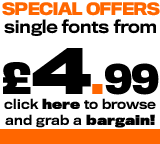|
 | Page 1 of 2 | |  | | | | 
 | | Exclusive Interview |
By: Brendan Staunton
Page 1 of 2 Like everyone says, there's a lot of type out there; and no matter how good a new font collection is, the real problem comes with getting it noticed. This is why the smarter designers don't just create typefaces, they also create distinctive identities for their type. Jeremy Tankard has done exactly that with his new collection: ' The Shire Types '. Everything about these fonts - the naming, the packaging and the whole visual appeal - is so strongly evocative of England at the time of the industrial revolution that you can almost hear the rumble from the factories and feel the steam and cold dust working their way into your lungs. "The idea of the Shires was to have this dense, black textural mass, so I took out the ascenders and descenders and just crammed everything together to make a block, so now you have all these dense black building blocks..." It was during his years at Wolff Olins working with those voguishly anorexic fonts so beloved of modern corporate designers, that Jeremy Tankard felt the first stirrings of revolt. Fat can be beautiful too, he thought as he attempted to throw some heavier weight fonts into the design mix - even going so far as to suggest Felicio and Bureau Grotesque for the Channel 5 launch, alas without success. "I don't think they got the point that it's how you use the type that counts. There's more to these fonts than just that familiar 'billboard' effect'." He also wanted to use more type based on English designs and it was ideas like these that forged the thinking behind The Shire Types. As an interviewee, Jeremy Tankard is a model of efficiency. He arrives early and ready prepared with business cards, biography and typed-up notes which update me on his work. Most valuable of all though is his notebook, wherein lies the story of The Shire Types. I order some coffees and ask how it all started. "The Shires were started before I went to Australia in 96 (he shows me the stamp on the page) . Then I put it to bed for six months whilst I was on holiday and when I came back I just ploughed back into it." So how did the idea come about? "It began as these very big, wide and condensed forms - really black and with really small counters. I just kept throwing questions back and forward. What variety of forms did I want? Did I want to keep it big and heavy? And then there was the question of descenders which I eventually decided to take out." That is one of the most distinctive aspects of the font... it evokes that historic feel. "Yes, compare them to the true historical faces such as John Hoffler's. He did a lot of black faces with industrial black heavy letterforms... all that ziggarut. He had a set of basic letterforms and he plugged on different serif styles. Font Bureau bureau grotesque are very clear interpretations of Stephenson's Blake original, but that's how they existed in the nineteenth century. I wanted to interpret them, rather than do a representation. It's a waste of time and effort just to recreate what went before." But that is only part of the story. As his book clearly shows, there were other ideas stirring in the pot, such as the Shires concept itself. "Right at the beginning..." (He leafs back through the book) "...I thought of this idea of the Shires. I was looking at 'The English Lettering Tradition, from 1700 to the present day' by Alan Bartram. You see here there's a section on the Clarendons and the Egyptians and the vernacular form of English lettering from which it all developed." He shows me an entry where he has actually written 'the Shire types' - at this stage, perhaps, as a kind of mental shorthand. The geographical origins of type seem to hold a fascination for him. "When Adobe developed multiple mastering, you could actually work, for the first time, from the polarity of a heavy letterform and a light letterform and mix them together for something inbetween. I toyed with this idea of a typeface where you could have a Scandinavian version, an Italian version, an English and whatever... perhaps a Polish one and you mix and match them from that point of view. Anyway my employers weren't too keen because they wanted their Garamond and whatever, but I really liked this notion of a typeface that could wander between these different areas of Europe, though you can't really do it because obviously there's no such thing as a genuine national type." I suggested that there was, in a way. "Yes, but they can't be blended." | |  |  | |
|
|
|
|
| | | Page 1 of 2 | next  |
 |
|
 
  

 | Guest |  |
 |
0 items |
 |
View |
 |
| Total |
 |
£ 0.00 |
 |  |
| |
|
| 
Receive regular e-news bulletins packed with new releases and special offers!
|
|
|
Key benefits:
- shop without c/card
- monthly invoice
- purchase history
- backup resource
- premium content
|
|
|  |
|  |
| |
|
| |
|
|


